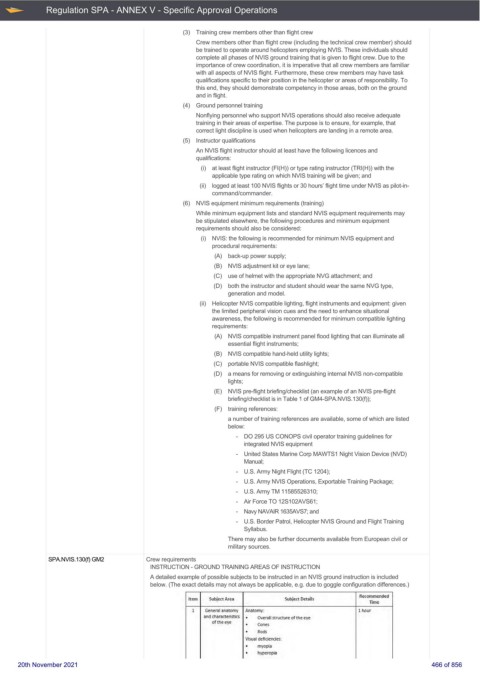Page 466 - UK Air Operations Regulations 201121
P. 466
~
~ Regulation SPA - ANNEX V - Specific Approval Operations Centrik
(3) Training crew members other than flight crew
Crew members other than flight crew (including the technical crew member) should
be trained to operate around helicopters employing NVIS. These individuals should
complete all phases of NVIS ground training that is given to flight crew. Due to the
importance of crew coordination, it is imperative that all crew members are familiar
with all aspects of NVIS flight. Furthermore, these crew members may have task
qualifications specific to their position in the helicopter or areas of responsibility. To
this end, they should demonstrate competency in those areas, both on the ground
and in flight.
(4) Ground personnel training
Nonflying personnel who support NVIS operations should also receive adequate
training in their areas of expertise. The purpose is to ensure, for example, that
correct light discipline is used when helicopters are landing in a remote area.
(5) Instructor qualifications
An NVIS flight instructor should at least have the following licences and
qualifications:
(i) at least flight instructor (FI(H)) or type rating instructor (TRI(H)) with the
applicable type rating on which NVIS training will be given; and
(ii) logged at least 100 NVIS flights or 30 hours’ flight time under NVIS as pilot-in-
command/commander.
(6) NVIS equipment minimum requirements (training)
While minimum equipment lists and standard NVIS equipment requirements may
be stipulated elsewhere, the following procedures and minimum equipment
requirements should also be considered:
(i) NVIS: the following is recommended for minimum NVIS equipment and
procedural requirements:
(A) back-up power supply;
(B) NVIS adjustment kit or eye lane;
(C) use of helmet with the appropriate NVG attachment; and
(D) both the instructor and student should wear the same NVG type,
generation and model.
(ii) Helicopter NVIS compatible lighting, flight instruments and equipment: given
the limited peripheral vision cues and the need to enhance situational
awareness, the following is recommended for minimum compatible lighting
requirements:
(A) NVIS compatible instrument panel flood lighting that can illuminate all
essential flight instruments;
(B) NVIS compatible hand-held utility lights;
(C) portable NVIS compatible flashlight;
(D) a means for removing or extinguishing internal NVIS non-compatible
lights;
(E) NVIS pre-flight briefing/checklist (an example of an NVIS pre-flight
briefing/checklist is in Table 1 of GM4-SPA.NVIS.130(f));
(F) training references:
a number of training references are available, some of which are listed
below:
- DO 295 US CONOPS civil operator training guidelines for
integrated NVIS equipment
- United States Marine Corp MAWTS1 Night Vision Device (NVD)
Manual;
- U.S. Army Night Flight (TC 1204);
- U.S. Army NVIS Operations, Exportable Training Package;
- U.S. Army TM 11585526310;
- Air Force TO 12S102AVS61;
- Navy NAVAIR 1635AVS7; and
- U.S. Border Patrol, Helicopter NVIS Ground and Flight Training
Syllabus.
There may also be further documents available from European civil or
military sources.
SPA.NVIS.130(f) GM2 Crew requirements
INSTRUCTION - GROUND TRAINING AREAS OF INSTRUCTION
A detailed example of possible subjects to be instructed in an NVIS ground instruction is included
below. (The exact details may not always be applicable, e.g. due to goggle configuration differences.)
Recommended
Item Subject Area Subject Detai Is
T1me
I General anatomy Anatomy: 1 hour
and characteristics Overa ll structure of the eye
of the eye .
. Cones
Rods
Vtsual deficiencies:
. myopia
hyperopia
20th November 2021 466 of 856

